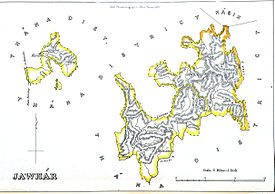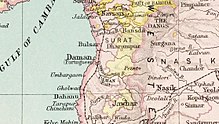
Back জওহার রাজ্য Bengali/Bangla Jawhar Catalan État de Jawhar French जव्हार रियासत Hindi Jawhar (stato) Italian जव्हार संस्थान Marathi Джаухар (княжество) Russian ஜவ்கார் சமஸ்தானம் Tamil
| Princely State of Jawhar | |||||||
|---|---|---|---|---|---|---|---|
| Princely State of British India | |||||||
| 1343–1947 | |||||||
 Jawhar State in Thana Agency during British India | |||||||
| Capital | Jawhar | ||||||
| Demonym | Koli people | ||||||
| Area | |||||||
• 1901 | 1,383.054[1] km2 (534.000 sq mi) | ||||||
| Population | |||||||
• 1901 | 50,538 | ||||||
| Government | |||||||
| • Type | Absolute Monarchy | ||||||
| • Motto | Jay Malhar (Victory to god Malhar) | ||||||
| Historical era | 19th century | ||||||
• Established | 1343 | ||||||
| 1947 | |||||||
| |||||||
| Today part of | |||||||


The Jawhar State[2] was a princely state in India. As a princely state, it became a part of Bombay Presidency during the British Raj.[3] It was the only state belonging to the Thana Agency.
The coat of arms consisted of a shield in three parts; dexter, tenne a dexter fist holding two crossed arrows (points dexter) and a bow, all argent; sinister, argent a round shield sable bordured or, in the chief argent, a sword or pointed sinister. The flag was a rectangular saffron swallow-tail with a star of eleven rays, yellow in the canton.
- ^ Thornton, Edward (1886). A Gazetteer of the Territories Under the Government of the Viceroy of India. W. H. Allen & Company.
- ^ Administration
- ^ Chisholm, Hugh, ed. (1911). . Encyclopædia Britannica. Vol. 15 (11th ed.). Cambridge University Press. p. 294.

